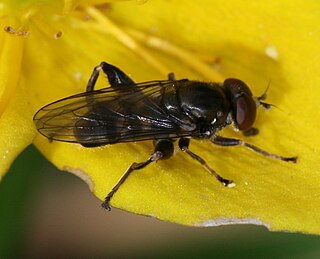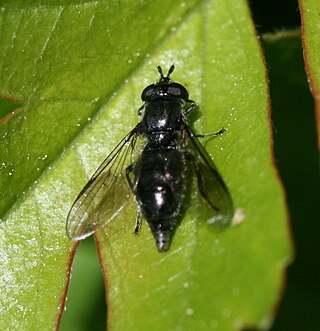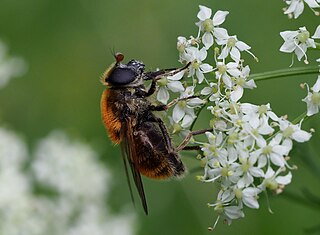
Xylota segnis, The Brown-toed Forest Fly, is a common species of hoverfly.

Criorhina berberina is a species of hoverfly. It is found in the Palaearctic from Fennoscandia South to Iberia and Italy. Ireland eastwards through Europe into Turkey and European Russia . C. berberina is a bumblebee mimic. The body has uniformly long dense pubescence, obscuring the ground-colour. There are two forms one with the pubescence more or less extensively blackish, one in which it is entirely yellow or tawny. Criorhina differ from other bumblebee mimics - Mallota, Arctophila, Pocota and Brachypalpus by the form of their antennae: the first segments are thin and form a stalk, the third segment is shorter than it is wide. In Criorhina, the face projects downwards, in contrast to Pocota and Brachypalpus.

Chalcosyrphus (Xylotomima) nemorum , the Dusky-banded Leafwalker, is a common species of syrphid fly with a Palearctic and Nearctic distribution. Hoverflies get their names from the ability to remain nearly motionless while in flight. The adults are also known as flower flies for they are commonly found around and on flowers, from which they get both energy-giving nectar and protein-rich pollen. Larvae have been found under the bark of Larix, Pinus and a variety of hardwoods.

Neoascia podagrica is a species of hoverfly.

Pipiza is a genus Hoverflies, from the family Syrphidae, in the order Diptera. Most are dark hoverflies.

Cheilosia albitarsis is an abundant European species of hoverfly. Adults can be found in spring visiting buttercup flowers and this plant is also the larval hostplant.

Pipiza noctiluca is a species of Hoverfly, from the family Syrphidae, in the order Diptera.

Pipiza austriaca is a species of hoverfly, from the family Syrphidae, in the order Diptera.

Pipiza bimaculata is a species of hoverfly, from the family Syrphidae, in the order Diptera.

Pipiza luteitarsis is a species of Hoverfly, from the family Syrphidae, in the order Diptera.
Pipizella maculipennis is a species of hoverfly, from the family Syrphidae, in the order Diptera.

Trichopsomyia flavitarsis is a European species of hoverfly.
Pipiza carbonaria is a species of hoverfly, from the family Syrphidae, in the order Diptera.
Pipiza fasciata is a species of hoverfly, from the family Syrphidae, in the order Diptera.
Pipiza notata is a species of hoverfly, from the family Syrphidae, in the order Diptera.
Pipiza signata is a species of hoverfly, from the family Syrphidae, in the order Diptera.

Cheilosia antiqua is a European species of hoverfly.

Cheilosia chrysocoma is a European species of hoverfly.

Cheilosia vulpina is a Palearctic hoverfly.












